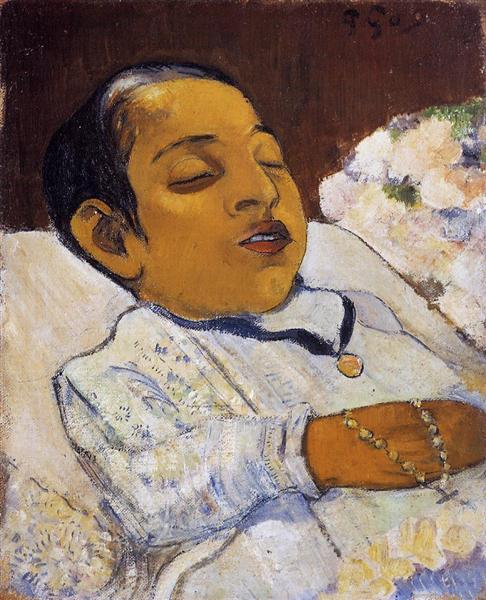Description
Paul Gauguin's Portrait of Atiti (1891) is a masterful fusion of color, form and symbolism that embodies the essence of post-impressionist art. Atiti, the Tahitian model who occupies the central composition, is presented with a penetrating gaze that invites the viewer to delve into her inner world. The choice of Atiti as a subject is not fortuitous; she represents not only an aesthetic ideal of Polynesian beauty, but is also a manifestation of Gauguin's search to connect with a deeper spirituality than that offered by Western culture, a recurring theme in his work after his arrival in Tahiti.
The composition is marked by Gauguin’s signature attention to form and use of line, which moves away from naturalism in favor of a more expressive use of color and form. The background of the work is filled with vibrant greenery that contrasts dramatically with Atiti’s skin tone, a symbol of the land around her and the intrinsic connection she has with her surroundings. This exuberant coloring, combined with the stylization of hair and clothing, reinforces the notion of a rich and unique cultural identity that is often overlooked in colonial narratives.
The use of color in “Portrait of Atiti” is particularly noteworthy. Gauguin uses saturated hues that create an almost dreamlike atmosphere, where each nuance not only describes the visible world, but also expresses deeper meanings. Atiti’s skin is bathed in warm brown tones, which contrast sharply with the green and blue background, suggesting a connection with the land and the sea, two central elements in the life of Tahitians. Through bold brushstrokes and a simplified palette, Gauguin achieves a representation that transcends the merely physical and delves into the spiritual and emotional.
Atiti’s figure is depicted with a serene yet intense face, suggesting both strength and vulnerability. This duality is a reflection of Gauguin’s own journey, which was torn between the search for artistic purity and the exploitation of cultures he idealized. Atiti’s gaze, direct and almost defiant, provokes an immediate connection with the viewer, making her a bridge between cultures and eras. This interaction raises questions about identity, representation, and the role of women in society, themes that resonate in contemporary discussions about art and cultural inclusion.
It is fascinating to note that Portrait of Atiti was created at a time when Gauguin was seeking to break away from the rigidities of European academic art. His stay in Tahiti marked a radical change in his style and his way of seeing the world. This work is situated within the broader context of his production on the island, where he made a series of exploratory works that immortalize the life, traditions and people he encountered, filling him with a sense of nostalgia and loss, reflecting his own search for a lost paradise.
“Portrait of Atiti” not only serves as a singular portrait, but also represents a compendium of Gauguin’s ideals about authenticity, life, and the human condition. This portrait embodies the essence of his legacy, in which art becomes a medium to explore the emotional connection between the artist, his subject, and the world around them. Through his tiny yet profound canvas, Gauguin invites viewers to observe not only the figure of Atiti, but the vibrant cultural and historical context she represents, underscoring the intricate web of relationships between art, identity, and place.
KUADROS ©, a famous painting on your wall.
Hand-made oil painting reproductions, with the quality of professional artists and the distinctive seal of KUADROS ©.
Painting reproduction service with satisfaction guarantee. If you are not completely satisfied with the replica of your painting, we will refund 100% of your money.

